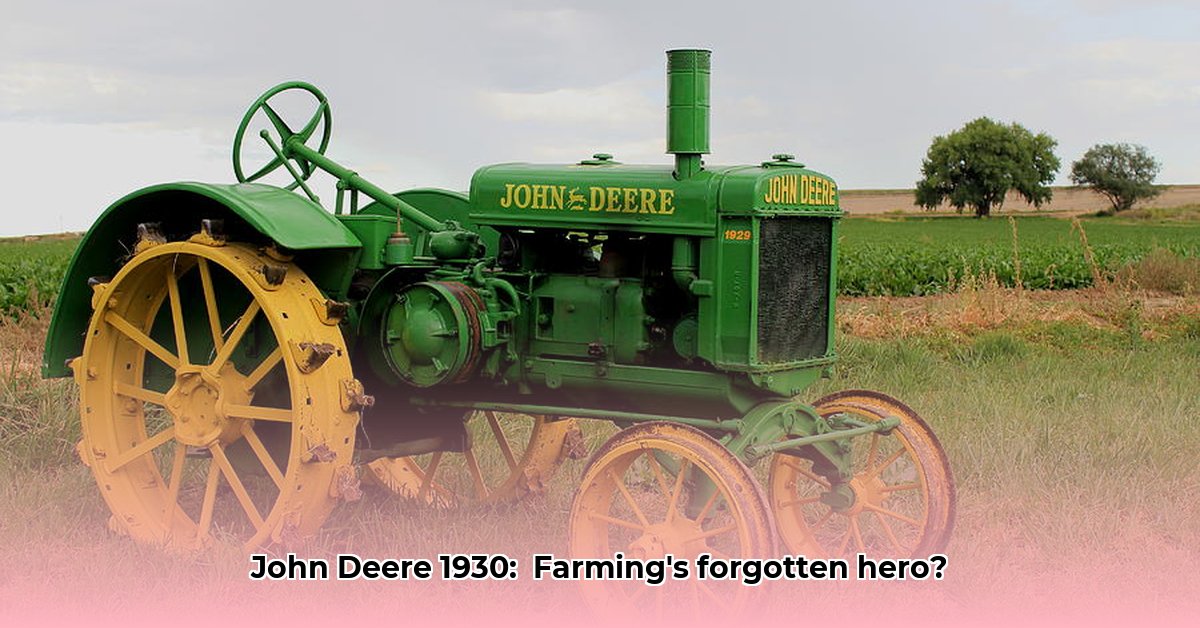
A Revolution on Wheels: The John Deere 1930 and the Dawn of Modern Agriculture
The deep rumble of a vintage John Deere tractor evokes more than just nostalgia; it whispers a story of agricultural transformation. The 1930 model, while not designed with modern sustainability in mind, stands as a pivotal moment in farming history, indirectly shaping the path towards environmentally conscious practices we see today. This isn't just about a piece of machinery; it's about the evolution of farming, from arduous manual labor to high-tech precision agriculture. For more on early John Deere models, see this site.
The 1930s saw a paradigm shift. Before the John Deere 1930, farming was largely a back-breaking endeavor, reliant on animal power and manual processes. The tractor's arrival dramatically altered this landscape. Its powerful engine and improved transmission enabled farmers to cultivate significantly larger areas in drastically shorter timeframes. This increase in efficiency, while not explicitly "sustainable" by today's metrics, had profound long-term consequences. Didn’t this unprecedented boost in productivity sow the seeds for future environmentally friendly practices by reducing the land required for production?
Technological Leaps and Bounds: From 1930 to Modern Marvels
While the 1930 model's fuel efficiency and environmental impact pale in comparison to modern standards, its ingenuity laid crucial groundwork. Its robust design and improved power transfer were significant steps forward. This isn't to romanticize its shortcomings; emissions weren't a concern then. Yet, it marked the beginning of a continuous improvement cycle.
Consider this evolution:
- Early Days (pre-1930s): Brute force and simple design dominated. Tractors were built for durability, prioritizing completion of the task above fuel economy or emissions reductions.
- Specialization (mid-20th Century): Tractors began to specialize; some for plowing, others for harvesting. This specialization dramatically improved efficiency, reducing waste and optimizing resource use.
- Precision Farming (late 20th and 21st Centuries): This era witnessed a revolution. GPS guidance, soil sensors, and data analytics allowed farmers to use precise amounts of water and fertilizers. This precision farming minimizes environmental impact while maximizing yields.
The 1930's Enduring Legacy: A Foundation for Sustainable Practices
While not inherently sustainable, the 1930 tractor's legacy is intrinsically linked to modern sustainability efforts. Its contribution to increased agricultural efficiency indirectly led to reduced land use for equivalent food production. This reduction in land usage, in turn, benefits biodiversity and reduces habitat encroachment. "The 1930 model's impact wasn't directly about environmental preservation; it was about boosted productivity, which is a crucial underpinning of modern sustainability," notes Dr. Anya Sharma, Agricultural Economist at Cornell University. This seemingly simple connection highlights the ripple effects of technological advancement and how seemingly disparate historical events contribute to contemporary sustainability goals.
The Path Forward: Sustainable Innovation
Current John Deere tractors represent a stark contrast to their 1930 predecessor. Modern models frequently prioritize sustainability, incorporating autonomous features, alternative fuels (like biofuels), and robotic harvesting tools. The emphasis is shifting towards drastically reducing the carbon footprint of agriculture and using resources more responsibly. This trajectory reflects a growing understanding of the interconnectedness of agricultural practices and environmental health.
But the work is far from over. Challenges remain. The reliance on fossil fuels in many current tractors, along with the energy intensity of manufacturing, presents a significant hurdle. Dr. David Miller, a leading expert in sustainable agriculture from Stanford University, emphasizes the need for further advancements in alternative fuels and circular economy principles in manufacturing. "We need to move beyond incremental improvements,” Dr. Miller states. “Real sustainability demands a fundamental shift in how we design, produce, and use these machines."
A Collaborative Future: Shaping Sustainable Agriculture
The pursuit of a truly sustainable agricultural future requires a collaborative, multifaceted approach. Farmers, manufacturers (like John Deere), governments, and consumers all play vital roles. Farmers need access to advanced technologies and support for implementing sustainable practices. Manufacturers must invest in research and development, focusing on sustainable materials, alternative fuels, and energy-efficient designs. Governments can offer incentives such as subsidies and implement regulations that encourage environmentally friendly approaches. And consumers have a critical role in supporting sustainably produced food through conscious purchasing.
The enduring legacy of the John Deere 1930 tractor underscores the incremental nature of progress. While not explicitly designed for sustainability, it laid the foundation for the efficiency gains that now underpin current strategies to mitigate environmental impact. The journey to a sustainable food system is an ongoing evolution – one built upon the successes and lessons learned from the past.